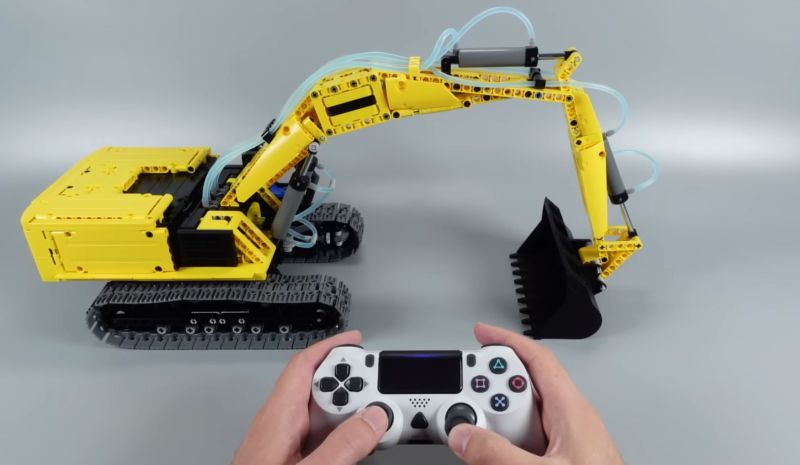Everyone already knows that Lego Technic is pretty rad when it comes to existing, pre-made kits, but there’s also quite a bit of hacking potential left. One such area is the lack of hydraulics in Lego Technic, an egregious oversight that [Brick Technology] simply had to correct. His effort results in a partially hydraulic, fully remote-controlled excavator. Rather than a traditional gear hydraulic pump as you’d expect in a real-life excavator, a custom peristaltic pump is used to move the fluid to the hydraulic cylinders (rams for our British and Oceanic friends).
The undercarriage is (sadly) purely electrical, with a slip-ring providing power to the electric final drives in the tracks, enabling it to spin around endlessly without limitations. Where the hydraulics come into play is in the excavator’s arm, with two hydraulic lift cylinders on the boom, one cylinder to control the stick, and a final cylinder to control the bucket. Rather than a hydraulic switch, the setup is simplified by using a single peristaltic pump per cylinder circuit.
Remote control and power are provided using the rather chonky BuWizz 3.0 Pro, which offers a wireless control link (here controlled using BrickController 2 on Android). Although original Lego cylinders were used, these are only intended for pneumatics, where it’s hoped that the used mixture of water and windscreen wiper fluid will prevent corrosion.
(Thanks to [Keith Olson] for the tip)















So, who’s going to be “that guy” and point out that Lego did a whole range of pneumatic sets?
https://en.m.wikipedia.org/wiki/Lego_pneumatics
I’ll be ‘that guy’ and point out that hydraulics is not pneumatics.
And if anyone actually looked at the link they’d be able to read:
The Hydraulic cylinders are actually Lego pneumatic cylinders. They are not intended to be used with water as the metal parts could corrode. To avoid this, I used a mixture of windscreen wiper fluid and water. The system requires some air, as the 2 cylinder chambers are different in size and therefore require a different amount of water. Each pump powers its own independent circuit and, respectively, 1 excavator arm joint.
What’s your point? We all know Lego has pneumatics. They’ve had them for a LONG time. The video creator is using water instead of air which makes it a hydraulic system not a pneumatic one.
i did something similar a long time ago. i had just got the 8868-1 claw rig. which had an electric compressor. since neither the switches nor the pistons had an outlet. using the parts i built a compressor and submerged the pump in a bowl of water, with the motor above connected by a shaft to “keep it dry”. the valves were in a control box of sorts, eternal, because they spew out water when used, thing made a mess.
ended up rusting a couple pistons and the motor contacts.. managed to restore the pistons with some scotch bright and metal polish, and gave them a re-lube. i still have them, used when i was doing lpes a few years ago. a good practice would be to re-lube them for storage, as you probibly have washed away the silicone grease they use with repeated cycling.
I had the 8851. It sucked. Figuratively and literally.
There was a build option to add the lego motor to make a compressor. It really didn’t help.
That’s why lego revised the pneumatics to a dual action cylinder.
Brilliant! Did you consider 3D printing a gear pump?
Windscreen wiper fluid does not contain corrosion inhibitors, radiator antifreeze would do this. But are the metal parts of the cyclinders really made of corrosion sensitive metal?
There are nice gear pumps which provide a few bar of pressure with 4 to 8V battery voltage on Aliexpress. I used one for a pressure sprayer. Probably more durable than a peristaltic pump.
Yes they are indeed, at least the older yellow/black style ones. I did a similar thing to this like 25 years ago with my old Technic pneumatic stuff
Could you share a link to one?
Great project, with a brilliant video!
So I’m guessing that using water makes this stronger than using air ? capable of lifting more ?